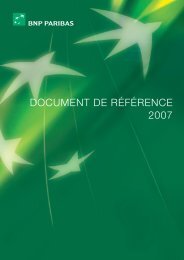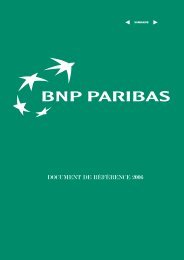2007 REGISTRATION DOCUMENT
2007 REGISTRATION DOCUMENT
2007 REGISTRATION DOCUMENT
- No tags were found...
Create successful ePaper yourself
Turn your PDF publications into a flip-book with our unique Google optimized e-Paper software.
5 NotesCONSOLIDATED FINANCIAL STATEMENTSto the financial s tatements p repared in accordance with I nternational Financial Reporting S tandards as adopted by the European Union< Contents >■ Policyholder behaviour is monitored on an ongoing basis, in order toregularly align the duration of assets with that of the correspondingliabilities and reduce the risk of abrupt, large-scale asset sales. Changesin assets and liabilities are projected over periods of up to 40 years,in order to identify mismatches giving rise to a liquidity risk. Theseanalyses are then used to determine the choice of maturities for newinvestments and the assets to be sold.■ In addition to the guaranteed yield, policyholders are paid dividendsthat raise the total yield to a level in line with market benchmarks.These dividends, which are partly discretionary, reduce the risk of anincrease in surrender rates in periods of rising market interest rates.■ The return on financial assets is protected mainly through the use ofhedging instruments.Unit-linked contracts with a capital guaranteeCertain unit-linked contracts include whole life cover providing for thepayment of a death benefit at least equal to the cumulative premiumsinvested in the contract, whatever the conditions on the financialmarkets at the time of the insured’s death. The risk on these contractsis both statistical (probability of a claim) and financial (market valueof the units).The capital guarantee is generally subject to certain limits. In France, forexample, most contracts limit the guarantee to one year and a maximumof EUR 765,000 per insured. In addition, the guarantee is not normallyavailable beyond the insured’s 80th birthday.The carrying amount of linked liabilities is equal to the sum of the fairvalues of the assets held in the unit-linked portfolios. The insurer’s liabilityis therefore covered by corresponding assets. The match between linkedliabilities and the related assets is checked at monthly intervals.The capital guarantee reserve takes into account the probability of death,based on a deterministic scenario, and stochastic analyses of changingfinancial market prices. The capital guarantee reserve amounted toEUR 27 million at 31 December <strong>2007</strong>, compared with EUR 40 millionat 31 December 2006.4.e.2Insurance subscription risksThe insurance subscription risks arise mainly in the Personal Risk business,which accounts for some 5% of the insurance subsidiaries’ liabilities.They result mainly from the sale of annuity policies in France and loanprotection insurance worldwide.The actuarial oversight system set up to prevent and control actuarialrisks in France and internationally is based on guidelines and toolsthat describe (i) the principles, rules, methods and best practices tobe followed by each actuary throughout the policies’ life cycle, (ii) thetasks to be performed by the actuaries and their reporting obligationsand (iii) practices that are banned or that are allowed only if certainconditions are met.Underwriting limits are set at various local and central levels, based oncapital at risk, estimated maximum acceptable losses and estimatedmargins on the policies concerned. The experience acquired in managinggeographically diversified portfolios is used to regularly update riskpricing databases comprising a wide range of criteria such as creditrisk, the type of guarantee and the insured population. Each contract ispriced by reference to the margin and return-on-equity targets set bythe executive management of BNP Paribas Assurance.Risk exposures from annuity and loan protection insurance business aremonitored at quarterly intervals by BNP Paribas Assurance’s ExecutiveCommittee, based on an analysis of loss ratios.Loss ratios for annuity contracts are based on mortality tables applicableunder insurance regulations, as adjusted by independent actuaries whereappropriate. Annuity risks are low.Loan protection insurance covers death, total or partial disability, loss ofemployment and financial loss risks for personal loans and home loans.The insurance book comprises a very large number of individual policiesrepresenting low risks and low premiums. Margins depend on the sizeof the insurance book, effective pooling of risks and tight control ofadministrative costs.Actual loss ratios are compared with forecast ratios on a regular basisby the actuarial department, and premium rates are adjusted whennecessary.The insurance subscription risks are covered by various technicalreserves, including the unearned premiums reserve generally calculatedon an accruals basis policy-by-policy, the outstanding claims reserve,determined by reference to reported claims, and the IBNR (claimsincurred but not reported) reserve, determined on the basis of eitherobserved settlements or the expected number of claims and the averagecost per claim.4.f IMPACT OF THE SUBPRIME CRISISIN SECOND-HALF <strong>2007</strong>4.f.1BackgroundDuring the second half of <strong>2007</strong>, financial market players were hit by theeffects of the housing market downturn in the United States. Subprimeborrowers (borrowers with poor credit histories) in the US, who had beenaggressively targeted by mortgage lenders, were plunged into seriousfinancial difficulties by rising interest rates, at a time when house priceswere falling, leading to a growing number of defaults.These high interest home loans were the subject of intense securitisationactivity, creating synthetic financial assets that were placed with vastnumbers of investors. Anticipating a significant decline in interest andcapital flows from the underlying loans, as a result of the subprime crisis,investors moved quickly to sell these synthetic assets, leading to a sharpdrop in their market prices.The subprime mortgage-backed securities were insured by creditenhancement companies in the United States, known as monolineinsurers because they write only one type of business. The potentialscale of the losses on subprime business as a result of the crisis was suchthat the monolines’ financial position was severely weakened. Holders ofthe insured securities and the monolines’ counterparties in derivativestransactions also had to assess the risk of the monolines being unable tofulfil their commitments in the case of default by subprime borrowers.1234567891011150<strong>2007</strong> Registration document - BNP PARIBAS
















